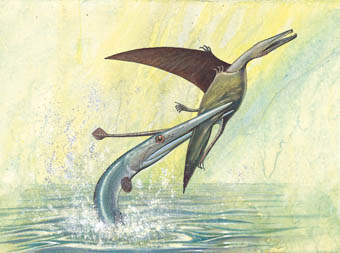
The researcher of the Universitat de València, Borja Holgado leads a study that has revealed that the bones, which were believed to belong to a flying reptile of the group of pterosaurs, were, actually, from a small reptile of the group of the protorosaurs that could have been eaten by a fish. The research has been published in ‘Plos One’ journal.
The research, of the Institut Català de Paleontologia Miquel Crusafont (ICP), has been made with new tools for the tridimensional analysis of fossilised stomach content from about 215 million years ago.
In the same way as bones, teeth, prints or even excrements from animals from the past also fossilise and are subject of study of palaeontologists in order to reconstruct the past. Undigested food also gives important information about the fauna that lived in our planet in other period of time.
Exceptionally, the fossil record provides food remains regurgitated by other animals, that is to say, thrown out of the mouth when they have already gone through the oesophagus or the stomach. The study published in ‘Plos One’ magazine by an international team of researchers focuses on a small accumulation of regurgitated bones found in 1989 near Preone (Udine, North-East of Italy).
In the first scientific article published that same year about that fossil, the rests were identified and described as an exceptional case of fossilised stomach content formed by rests of pterosaur bones. Pterosaurs are a group of flying reptiles that lived during most of the Mesozoic Era (between 252 and 66 million years ago). The animal would have been captured and partially eaten by a fish of considerable dimensions. With the availabre technology at that moment, the rests were atributed to the only pterosaur that was described in that area, Preondactylus buffarinii.
Researchers from the Institut Català de Paleontologia Miquel Crusafont (ICP) studied the rests again, this time using a computerised tomography device which allowed obtaining high resolution images of the sample and, specially, from the interior of the hidden face of the piece, revealing previously unknown anatomical features. And they have reached a different conclusion. “The anatomical study of these images, does not only support the hypothesis that it is a pterosaur, but also has revealed certain correspondence with the protorosaurs and, more specifically, with the Langobardisaurus pandolfii specie”, explains Borja Holgado, main researcher of this study.
The new study has revealed specific features from this group in the previously bones attributed to pterosaur. “The morphology of the extended vertebrae now identified as cervical and the articular facets (surface where vertebrae joint) of the dorsal are the most prominent features that permitted this new interpretation of the specimen”, says the researcher.
Protorosaurs are a group of reptiles with long neck similar to current lizards that lived from the end of the Permian Era to the end of the Treassic Era, between 260 and 210 million years ago, shortly before dinosaurs dominated all terrestrial ecosystems.
Researcher Fabio M. Dalla Vecchia, who has also participated in the research, is one of the researchers that in the 90s attributed the rests to a pterosaur and it was Dalla Vecchia himself who proposed the review of this fossil. “The current work confirms that it is a stomach regurgitation possibly produced by a large fish, as we already pointed out in the first study”, says Dalla Vecchia. The rocks where the fossil was found had marine origins, but there is no evidence of marine predator reptiles in the geological formation where the specimen comes from and neither in coetaneous units in a vast area around the upwelling. “As a result, a fish is the best candidate as the maker of the rests”, explains Dalla Vecchia.
The presence of a vertebrate -presumably in terrestrial habitats- in a marine formation is not so unexpected. The palaeontological record of the fossiliferous locality includes abundant remains from terrestrial organisms (reptiles, plants and a spider) as well as organic matter with terrenial origin.
The main researcher is also an adjunct researcher in Universitat de València. In this research, researchers from the International Centre for Theoretical Physics (ICTP) have also participated.
More Info: Holgado B, Dalla Vecchia FM, Fortuny J, Bernardini F, Tuniz C (2015) A Reappraisal of the Purported Gastric Pellet with Pterosaurian Bones from the Upper Triassic of Italy. PLoS ONE 10(11):e0141275. doi: 10.1371/journal.pone.0141275
Last update: 12 de november de 2015 08:52.
News release



















